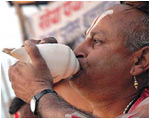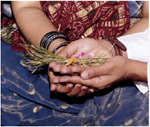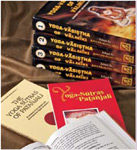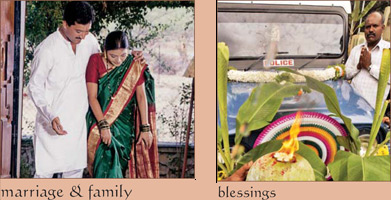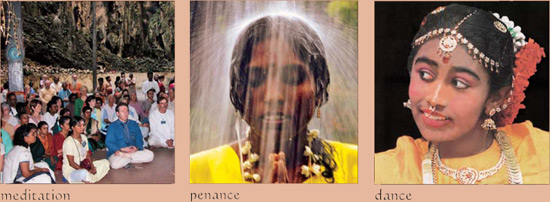
Hindu Scriptures
Ancient holy texts revealed by God and man§
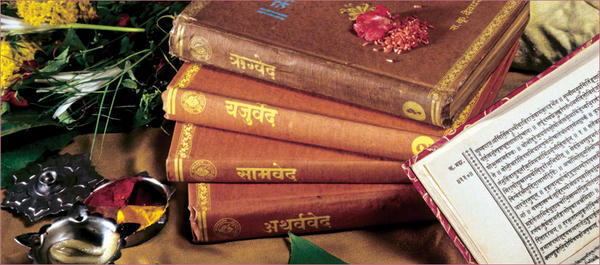
The Word, verily, is greater than name. The Word, in fact, makes known the Rig Veda, the Yajur Veda, the Sama Veda, the Atharva Veda as the fourth, and the ancient lore as the fifth: the Veda of Vedas, the ritual for ancestors, calculus, the augural sciences, the knowledge of the signs of the times, ethics, political science, sacred knowledge, theology, knowledge of the spirits, military science, astrology, the science of snakes and of celestial beings.§
Sama Veda, Chandogya Upanishad 7.2.1.
The Vedic Experience, Panikkar, p. 11§
Than whom there is naught else higher, than whom there is naught smaller, naught greater, the One stands like a tree established in heaven. By Him, the Person, is this whole universe filled.§
Krishna Yajur Veda,
Shvetashvatara Upanishad 3.9,
The Principal Upanishads, Radhakrishnan, p. 727§
The man who rejects the words of the scriptures and follows the impulse of desire attains neither his perfection, nor joy, nor the Path Supreme. Let the scriptures be, therefore, thy authority as to what is right and what is not right.§
Bhagavad Gita 16.23-24, Mascaro, p. 111§
Presenting a mountaintop view of the vast library of wisdom that molds and influences Hindu life§
 induism proudly embraces an incredibly rich collection of scripture. The holiest and most revered are the Vedas and Agamas, two massive compendia of shruti (that which is “heard”), both revealed by God to illumined sages centuries and millennia ago. The array of works known as smriti (that which is “remembered”) is equally vast, the most prominent and widely celebrated of which are the Itihasas (epic dramas and history)—the Ramayana and Mahabharata— and the Puranas (mythology). The Vedic arts and sciences, including ayurveda, astrology, music, dance, architecture, statecraft, domestic duty and law, are reflected in an assembly of texts known as Vedangas and Upavedas. Moreover, through the ages God-realized souls, sharing their experience, have poured forth volume upon volume that reveal the wonders of yoga and offer passionate hymns of devotion. The creation of Hindu scripture continues to this day, as contemporary masters reiterate the timeless truths to guide souls on the path to Divinity. In this Educational Insight, we offer a simple overview of Hindu scripture and an anthology of verses from this luminous library of dharma.§
induism proudly embraces an incredibly rich collection of scripture. The holiest and most revered are the Vedas and Agamas, two massive compendia of shruti (that which is “heard”), both revealed by God to illumined sages centuries and millennia ago. The array of works known as smriti (that which is “remembered”) is equally vast, the most prominent and widely celebrated of which are the Itihasas (epic dramas and history)—the Ramayana and Mahabharata— and the Puranas (mythology). The Vedic arts and sciences, including ayurveda, astrology, music, dance, architecture, statecraft, domestic duty and law, are reflected in an assembly of texts known as Vedangas and Upavedas. Moreover, through the ages God-realized souls, sharing their experience, have poured forth volume upon volume that reveal the wonders of yoga and offer passionate hymns of devotion. The creation of Hindu scripture continues to this day, as contemporary masters reiterate the timeless truths to guide souls on the path to Divinity. In this Educational Insight, we offer a simple overview of Hindu scripture and an anthology of verses from this luminous library of dharma.§
The stack of books at above holds one bound volume from each of the four Vedas in the Sanskrit language. For centuries they have been the basis of philosophical discussion, study and commentary. The Vedas are also the subject of deep study and meditation, to realize the wisdom of the ancients within oneself. Their mantras are chanted and used in rites of worship, prayer and japa.§

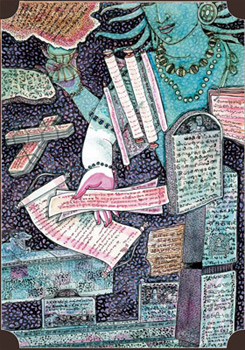 What Are Hindu Revealed Scriptures?
What Are Hindu Revealed Scriptures?
The Vedas and Agamas, revealed by God, are Hinduism’s sovereign scriptures, called shruti, “that which is heard.” Their timeless truths are expressed in the most extraordinarily profound mystical poetry known to man. Aum.§
Above, God holds the holiest of scriptures, the Vedas and Agamas. Around these are an array of other scriptures, enscribed on stone, wood, pillars and scrolls. At left, we see a copy of the Rig Veda Samhita. In the dimmed background, lamps are offered, as prescribed in the Agamas, by priests at Nallur Kandaswamy Temple in Sri Lanka.§
 EDA, FROM VID, “TO KNOW,” MEANS “SUPREME wisdom or science.” Similarly, Agama, which names the sacred sectarian revelations, means “descent of knowledge.” The Vedas and Agamas are eternal truths transmitted by God through great clairaudient and clairvoyant rishis. They are Hinduism’s primary and most authoritative scriptures, expounding life’s sacredness and man’s purpose on the planet. These psalms of wisdom were disclosed over many centuries, memorized and orally conveyed from generation to generation within priestly families, then finally written down in Sanskrit in the last few millennia. The subtly symbolic language of shruti, the cherished word of God, is lyrical and lofty. In imparting religious practice, rules and doctrine, the Vedas are general and the Agamas specific. The Vedas extol and invoke a multiplicity of Gods through elaborate fire rituals called yajna. The Agamas center around a single Deity and His worship with water, flowers and lights in sanctified temples and shrines. The Tirumantiram lauds, “Two are the scriptures that Lord Siva revealed—the primal Vedas and the perfect Agamas.” Aum Namah Sivaya.§
EDA, FROM VID, “TO KNOW,” MEANS “SUPREME wisdom or science.” Similarly, Agama, which names the sacred sectarian revelations, means “descent of knowledge.” The Vedas and Agamas are eternal truths transmitted by God through great clairaudient and clairvoyant rishis. They are Hinduism’s primary and most authoritative scriptures, expounding life’s sacredness and man’s purpose on the planet. These psalms of wisdom were disclosed over many centuries, memorized and orally conveyed from generation to generation within priestly families, then finally written down in Sanskrit in the last few millennia. The subtly symbolic language of shruti, the cherished word of God, is lyrical and lofty. In imparting religious practice, rules and doctrine, the Vedas are general and the Agamas specific. The Vedas extol and invoke a multiplicity of Gods through elaborate fire rituals called yajna. The Agamas center around a single Deity and His worship with water, flowers and lights in sanctified temples and shrines. The Tirumantiram lauds, “Two are the scriptures that Lord Siva revealed—the primal Vedas and the perfect Agamas.” Aum Namah Sivaya.§

 What Is the Nature of the Veda Texts?
What Is the Nature of the Veda Texts?
The holy Vedas, man’s oldest scripture, dating back 6,000 to 8,000 years, are a collection of four books: the Rig, Sama, Yajur and Atharva. Each has four sections: hymns, rites, interpretation and philosophical instruction. Aum.§
Above, using the traditional elutani, stylus, a pandit scribes memorized Vedic verses on dried palm leaves. For centuries the Vedas were passed on orally, then finally transcribed. Left, a devotee leafs through his holy text as he performs his morning sadhana.§
 HE OLDEST AND CORE PORTIONS OF THE Vedas ARE the four Samhitas, “hymn collections.” They consist of invocations to the One Divine and the Divinities of nature—such as the Sun, the Rain, the Wind, the Fire and the Dawn—as well as prayers for matrimony, progeny, prosperity, concord, domestic rites, formulas for magic, and more. They are composed in beautiful metrical verses, generally of three or four lines. The heart of the entire Veda is the 10,552-verse Rig Samhita. The Sama and Yajur Samhitas, each with about 2,000 verses, are mainly liturgical selections from the Rig, whereas most of the Atharva Samhita’s nearly 6,000 verses of prayers, charms and rites are unique. The Sama is arranged for melodious chanting, the Yajur for cadenced intonation. Besides its Samhita, each Veda includes one or two Brahmanas, ceremonial handbooks, and Aranyakas, ritual interpretations, plus many inestimable Upanishads, metaphysical dialogs. In all there are over 100,000 Vedic verses, and some prose, in dozens of texts. The Tirumantiram confirms, “There is no dharma other than what the Vedas say. Dharma’s central core the Vedas proclaim.” Aum Namah Sivaya.§
HE OLDEST AND CORE PORTIONS OF THE Vedas ARE the four Samhitas, “hymn collections.” They consist of invocations to the One Divine and the Divinities of nature—such as the Sun, the Rain, the Wind, the Fire and the Dawn—as well as prayers for matrimony, progeny, prosperity, concord, domestic rites, formulas for magic, and more. They are composed in beautiful metrical verses, generally of three or four lines. The heart of the entire Veda is the 10,552-verse Rig Samhita. The Sama and Yajur Samhitas, each with about 2,000 verses, are mainly liturgical selections from the Rig, whereas most of the Atharva Samhita’s nearly 6,000 verses of prayers, charms and rites are unique. The Sama is arranged for melodious chanting, the Yajur for cadenced intonation. Besides its Samhita, each Veda includes one or two Brahmanas, ceremonial handbooks, and Aranyakas, ritual interpretations, plus many inestimable Upanishads, metaphysical dialogs. In all there are over 100,000 Vedic verses, and some prose, in dozens of texts. The Tirumantiram confirms, “There is no dharma other than what the Vedas say. Dharma’s central core the Vedas proclaim.” Aum Namah Sivaya.§

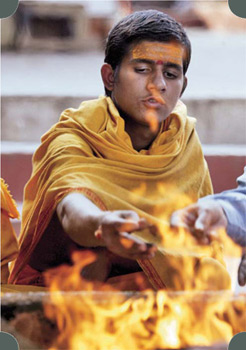 How Are the Vedas Significant Today?
How Are the Vedas Significant Today?
The Vedas, the ultimate scriptural authority, permeate Hinduism’s thought, ritual and meditation. They open a rare window into ancient Bharata society, proclaiming life’s sacredness and the way to oneness with God. Aum.§
Above, a young Smarta priest conducts a fire ceremony, havana, as decreed in the Vedas. At left, a Vaishnava priest blows a conch horn during prayers in Allahabad. Background photo, at Manikarnika Ghat in Varanasi, a priest performs antyeshti, the cremation ritual, last in the series of rites of passage prescribed in the Vedas.§
 IKE THE TAOIST TAO TE CHING, THE BUDDHIST Dhammapada, the Sikh Adi Granth, the Jewish Torah, the Christian Bible and the Muslim Koran, the Veda is the Hindu holy book. For untold centuries unto today, it has remained the sustaining force and authoritative doctrine, guiding followers in ways of worship, duty and enlightenment—upasana, dharma and jnana. The Vedas are the meditative and philosophical focus for millions of monks and a billion seekers. Their stanzas are chanted from memory by priests and laymen daily as liturgy in temple worship and domestic ritual. All Hindus wholeheartedly accept the Vedas, yet each draws selectively, interprets freely and amplifies abundantly. Over time, this tolerant allegiance has woven the varied tapestry of Bharata Dharma. Today the Vedas are published in Sanskrit, English, French, German and other languages. But it is the metaphysical and popular Upanishads which have been most amply and ably translated. The Vedas say, “Just as the spokes are affixed to the hub of a wheel, so are all things established in life, the Rig and Yajur and Sama Veda, sacrifice, the nobility and also the priesthood.” Aum Namah Sivaya.§
IKE THE TAOIST TAO TE CHING, THE BUDDHIST Dhammapada, the Sikh Adi Granth, the Jewish Torah, the Christian Bible and the Muslim Koran, the Veda is the Hindu holy book. For untold centuries unto today, it has remained the sustaining force and authoritative doctrine, guiding followers in ways of worship, duty and enlightenment—upasana, dharma and jnana. The Vedas are the meditative and philosophical focus for millions of monks and a billion seekers. Their stanzas are chanted from memory by priests and laymen daily as liturgy in temple worship and domestic ritual. All Hindus wholeheartedly accept the Vedas, yet each draws selectively, interprets freely and amplifies abundantly. Over time, this tolerant allegiance has woven the varied tapestry of Bharata Dharma. Today the Vedas are published in Sanskrit, English, French, German and other languages. But it is the metaphysical and popular Upanishads which have been most amply and ably translated. The Vedas say, “Just as the spokes are affixed to the hub of a wheel, so are all things established in life, the Rig and Yajur and Sama Veda, sacrifice, the nobility and also the priesthood.” Aum Namah Sivaya.§

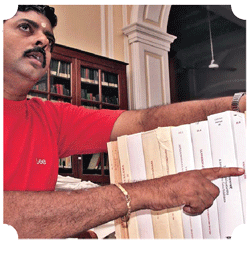 What Is the Nature of the Holy Agamas?
What Is the Nature of the Holy Agamas?
The Agamas, Sanatana Dharma’s second authority, are revelations on sacred living, worship, yoga and philosophy. Saivism, Shaktism and Vaishnavism each exalts its own array of Agamas, many more than 2,000 years old. Aum.§
Above, Dr. Ganesan, a scholar at the French Institute of Pondicherry, India, shows the volumes of Saiva Agamas they have printed to date. They are keepers of 8,000 ancient manuscripts, mostly palm-leaf books, such as those seen stored on shelves on the left, which one day will be published to the world. In the background, a devotee offers flowers to the Lord.§
 N THE VAST AGAMIC LITERATURE, TRADITION counts 92 main Saiva Agamas—10 Siva, 18 Rudra and 64 Bhairava—77 Shakta Agamas and 108 Vaishnava Pancharatra Agamas. Most Agamas are of four parts, called padas, and possess thousands of metered Sanskrit verses, usually of two lines. The charya pada details daily religious observance, right conduct, the guru-shishya relationship, community life, house design and town planning. The kriya pada, commonly the longest, extols worship and temples in meticulous detail—from site selection, architectural design and iconography, to rules for priests and the intricacies of daily puja, annual festivals and home-shrine devotionals. The yoga pada discloses the interior way of meditation, of raja yoga, mantra and tantra, which stimulates the awakening of the slumbering serpent, kundalini. The jnana pada narrates the nature of God, soul and world, and the means for liberation. The Tirumantiram declares, “Veda and Agama are Iraivan’s scriptures. Both are truth: one is general, the other specific. While some say these words of God reach two different conclusions, the wise see no difference.” Aum Namah Sivaya.§
N THE VAST AGAMIC LITERATURE, TRADITION counts 92 main Saiva Agamas—10 Siva, 18 Rudra and 64 Bhairava—77 Shakta Agamas and 108 Vaishnava Pancharatra Agamas. Most Agamas are of four parts, called padas, and possess thousands of metered Sanskrit verses, usually of two lines. The charya pada details daily religious observance, right conduct, the guru-shishya relationship, community life, house design and town planning. The kriya pada, commonly the longest, extols worship and temples in meticulous detail—from site selection, architectural design and iconography, to rules for priests and the intricacies of daily puja, annual festivals and home-shrine devotionals. The yoga pada discloses the interior way of meditation, of raja yoga, mantra and tantra, which stimulates the awakening of the slumbering serpent, kundalini. The jnana pada narrates the nature of God, soul and world, and the means for liberation. The Tirumantiram declares, “Veda and Agama are Iraivan’s scriptures. Both are truth: one is general, the other specific. While some say these words of God reach two different conclusions, the wise see no difference.” Aum Namah Sivaya.§

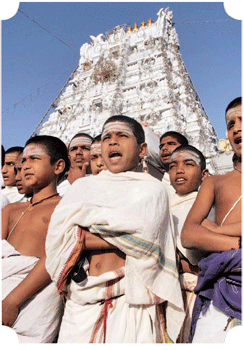 How Are the Agamas Significant Today?
How Are the Agamas Significant Today?
While the Vedas, with myriad Deities, bind all Hindus together, the Agamas, with a single supreme God, unify each sect in a oneness of thought, instilling in adherents the joyful arts of divine adoration. Aum Namah Sivaya.§
Like millions of Hindus before them, the youth in these two photos are learning precise recitation of liturgy from the Agamas and Vedas. They will spend years perfecting this training, enabling them to perform ritual worship, puja, in temples around the world. In their priest school in Tirupati, India, they will memorize hundreds of mantras.§
 OD IS LOVE, AND TO LOVE GOD IS THE pure path prescribed in the Agamas. Veritably, these texts are God’s own voice admonishing the samsari, reincarnation’s wanderer, to give up love of the transient and adore instead the Immortal. How to love the Divine, when and where, with what mantras and visualizations and at what auspicious times, all this is preserved in the Agamas. The specific doctrines and practices of day-to-day Hinduism are nowhere more fully expounded than in these revelation hymns, delineating everything from daily work routines to astrology and cosmology. So overwhelming is Agamic influence in the lives of most Hindus, particularly in temple liturgy and culture, that it is impossible to ponder modern Sanatana Dharma without these discourses. While many Agamas have been published, most remain inaccessible, protected by families and guilds who are stewards of an intimate hereditary knowledge. The Tirumantiram says, “Nine are the Agamas of yore, in time expanded into 28, they then took divisions three, into one truth of Vedanta-Siddhanta to accord. That is Suddha Saiva, rare and precious.” Aum Namah Sivaya.§
OD IS LOVE, AND TO LOVE GOD IS THE pure path prescribed in the Agamas. Veritably, these texts are God’s own voice admonishing the samsari, reincarnation’s wanderer, to give up love of the transient and adore instead the Immortal. How to love the Divine, when and where, with what mantras and visualizations and at what auspicious times, all this is preserved in the Agamas. The specific doctrines and practices of day-to-day Hinduism are nowhere more fully expounded than in these revelation hymns, delineating everything from daily work routines to astrology and cosmology. So overwhelming is Agamic influence in the lives of most Hindus, particularly in temple liturgy and culture, that it is impossible to ponder modern Sanatana Dharma without these discourses. While many Agamas have been published, most remain inaccessible, protected by families and guilds who are stewards of an intimate hereditary knowledge. The Tirumantiram says, “Nine are the Agamas of yore, in time expanded into 28, they then took divisions three, into one truth of Vedanta-Siddhanta to accord. That is Suddha Saiva, rare and precious.” Aum Namah Sivaya.§

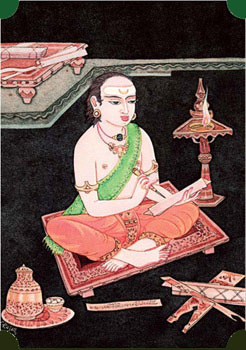 Do Smriti and Sacred Literature Differ?
Do Smriti and Sacred Literature Differ?
Hindu sacred literature is a treasury of hymns, legend, mythology, philosophy, science and ethics. From among this vast body of writings, each lineage recognizes a select portion as its secondary scripture, called smriti. Aum.§
Above, Masako Ono voyaged from Japan to India to learn the ancient Odissi dance style and remained there to teach it. The many human arts are found in ancient scripture. At left, a collection of Hindu holy texts stacked in a Delhi store. In the background, two girls reverently touch the holy feet of Lord Vishnu at a shrine in Tirupati.§
 HILE THE VEDAS AND AGAMAS ARE SHARED as part of every Hindu’s primary scripture, shruti, each sect and lineage defines its own unique set of smriti. The sacred literature, punya shastra, from which smriti is drawn consists of writings, both ancient and modern, in many languages. Especially central are the ancient Sanskritic texts, such as the Itihasas, Puranas and Dharma Sastras, which are widely termed the classical smriti. In reality, while many revere these as smriti, others regard them only as sacred literature. Smriti means “that which is remembered” and is known as “the tradition,” for it derives from human insight and experience and preserves the course of culture. While shruti comes from God and is eternal and universal, the ever-growing smriti canon is written by man. Hinduism’s sacred literature is the touchstone of theater and dance, music, song and pageantry, yoga and sadhana, metaphysics and ethics, exquisite art and hallowed sciences. The Vedas inquire, “In whom are set firm the firstborn seers, the hymns, the songs and the sacrificial formulas, in whom is established the single seer—tell me of that support—who may He be?” Aum Namah Sivaya.§
HILE THE VEDAS AND AGAMAS ARE SHARED as part of every Hindu’s primary scripture, shruti, each sect and lineage defines its own unique set of smriti. The sacred literature, punya shastra, from which smriti is drawn consists of writings, both ancient and modern, in many languages. Especially central are the ancient Sanskritic texts, such as the Itihasas, Puranas and Dharma Sastras, which are widely termed the classical smriti. In reality, while many revere these as smriti, others regard them only as sacred literature. Smriti means “that which is remembered” and is known as “the tradition,” for it derives from human insight and experience and preserves the course of culture. While shruti comes from God and is eternal and universal, the ever-growing smriti canon is written by man. Hinduism’s sacred literature is the touchstone of theater and dance, music, song and pageantry, yoga and sadhana, metaphysics and ethics, exquisite art and hallowed sciences. The Vedas inquire, “In whom are set firm the firstborn seers, the hymns, the songs and the sacrificial formulas, in whom is established the single seer—tell me of that support—who may He be?” Aum Namah Sivaya.§

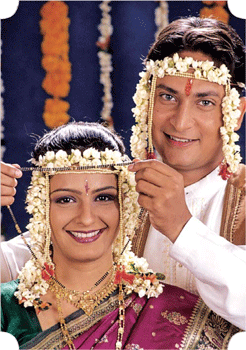 What Texts Amplify Vedas and Agamas?
What Texts Amplify Vedas and Agamas?
Many texts support the Vedas and Agamas. Vedangas detail conduct, astrology, language and etymology. Upavedas unfold politics, health, warfare and music. Upagamas and Paddhatis elaborate the Agamic wisdom. Aum.§
Above, a bride and groom are in the midst of their wedding; at left they hold an offering of sacred grasses; wedding chants derive from the Vedas, Agamas and ancillary texts; attitudes and guidelines for family life are found in the Sutras and Shastras. In the background photo, a girl receives sacraments after a puja.§
 UCH OF HINDUISM’S PRACTICAL KNOWLEDGE is safeguarded in venerable texts which amplify shruti. The Vedangas and Upavedas are collections of texts that augment and apply the Vedas as a comprehensive system of sacred living. Jyotisha Vedanga delineates auspicious timing for holy rites. Kalpa Vedanga defines public rituals in the Srauta and Sulba Sutras, domestic rites in the Grihya Sutras and religious law in the Dharma Sastras. Four other Vedangas ensure the purity of mantra recitation, through knowledge of phonetics, grammar, poetry and the way of words. The Upavedas expound profound sciences: Arthaveda unfolds statecraft; Ayurveda sets forth medicine and health; Dhanurveda discusses military science; Gandharvaveda illumines music and the arts; and Sthapatyaveda explains architecture. In addition, the Kama Sutras detail erotic pleasures. The Agamas, too, have ancillary texts, such as the Upagamas and Paddhatis, which elaborate the ancient wisdom. The Jnaneshvari says, “The Vedas in their perfection are as the beautiful image of the God of which the flawless words are the resplendent body. The smritis are the limbs thereof.” Aum Namah Sivaya.§
UCH OF HINDUISM’S PRACTICAL KNOWLEDGE is safeguarded in venerable texts which amplify shruti. The Vedangas and Upavedas are collections of texts that augment and apply the Vedas as a comprehensive system of sacred living. Jyotisha Vedanga delineates auspicious timing for holy rites. Kalpa Vedanga defines public rituals in the Srauta and Sulba Sutras, domestic rites in the Grihya Sutras and religious law in the Dharma Sastras. Four other Vedangas ensure the purity of mantra recitation, through knowledge of phonetics, grammar, poetry and the way of words. The Upavedas expound profound sciences: Arthaveda unfolds statecraft; Ayurveda sets forth medicine and health; Dhanurveda discusses military science; Gandharvaveda illumines music and the arts; and Sthapatyaveda explains architecture. In addition, the Kama Sutras detail erotic pleasures. The Agamas, too, have ancillary texts, such as the Upagamas and Paddhatis, which elaborate the ancient wisdom. The Jnaneshvari says, “The Vedas in their perfection are as the beautiful image of the God of which the flawless words are the resplendent body. The smritis are the limbs thereof.” Aum Namah Sivaya.§

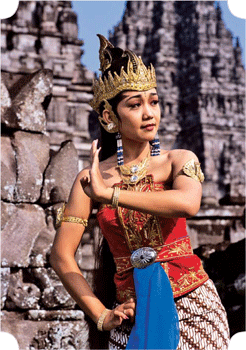 Does Hinduism Have Epics and Myths?
Does Hinduism Have Epics and Myths?
The Mahabharata and Ramayana are Hinduism’s most renowned epic histories, called Itihasa. The Puranas are popular folk narratives, teaching faith, belief and ethics in mythology, allegory, legend and symbolism. Aum.§
Above, a woman performs a dance depicting a scene from the Ramayana in Java, where the world-renowned epic is widely depicted in gala dance and theater. At left, Sanskrit volumes of the famed poem are shown, along with Hinduism’s other epic, the Mahabharata.§
 INDUISM’S POETIC STORIES OF RISHIS, Gods, heroes and demons are sung by gifted panditas and traveling bards, narrated to children and portrayed in dramas and festivals. The Mahabharata, the world’s longest epic poem, is the legend of two ancient dynasties whose great battle of Kurukshetra is the scene of the Bhagavad Gita, the eloquent spiritual dialog between Arjuna and Krishna. The Ramayana relates the life of Rama, a heroic king revered as the ideal man. The Puranas, like the Mahabharata, are encyclopedic in scope, containing teachings on sadhana, philosophy, dharma, ritual, language and the arts, architecture, agriculture, magic charms and more. Of 18 principal Puranas, six honor God as Siva, six as Vishnu and six as Brahma. The witty Panchatantra, eminent among the “story” literature, or katha, portrays wisdom through animal fables and parables. The Bhagavad Gita proclaims, “He who reads this sacred dialog of ours, by him I consider Myself worshiped through the sacrifice of knowledge. And the man who listens to it with faith and without scoffing, liberated, he shall attain to the happy realm of the righteous.” Aum Namah Sivaya.§
INDUISM’S POETIC STORIES OF RISHIS, Gods, heroes and demons are sung by gifted panditas and traveling bards, narrated to children and portrayed in dramas and festivals. The Mahabharata, the world’s longest epic poem, is the legend of two ancient dynasties whose great battle of Kurukshetra is the scene of the Bhagavad Gita, the eloquent spiritual dialog between Arjuna and Krishna. The Ramayana relates the life of Rama, a heroic king revered as the ideal man. The Puranas, like the Mahabharata, are encyclopedic in scope, containing teachings on sadhana, philosophy, dharma, ritual, language and the arts, architecture, agriculture, magic charms and more. Of 18 principal Puranas, six honor God as Siva, six as Vishnu and six as Brahma. The witty Panchatantra, eminent among the “story” literature, or katha, portrays wisdom through animal fables and parables. The Bhagavad Gita proclaims, “He who reads this sacred dialog of ours, by him I consider Myself worshiped through the sacrifice of knowledge. And the man who listens to it with faith and without scoffing, liberated, he shall attain to the happy realm of the righteous.” Aum Namah Sivaya.§

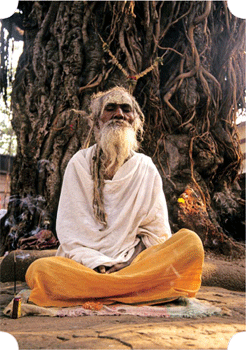 Are There Other Types of Sacred Texts?
Are There Other Types of Sacred Texts?
India’s lofty philosophical texts expound diverse views in exacting dialectics. Yoga treatises unveil the mysterious path to ultimate samadhis. Intimate devotional hymns disclose the raptures of consummate Divine love. Aum.§
Above, a recluse, clearly immersed in his yoga sadhana, sits in meditation beneath a gnarled banyan tree. At left are displayed two primary yoga scriptures, Yoga Sutras and Yoga Vashishtha. In the background, a young lady lights a ghee lamp to offer in personal worship, as her ancestors have done for centuries.§
 N ADDITION TO THE EPICS, LEGENDS AND SUPPLEMENTS to the Vedas and Agamas, there is a wealth of Hindu metaphysical, yogic and devotional writings. Considered foundational are the early texts defining the six philosophical darshanas: the sutras by Kapila, Patanjali, Jaimini, Badarayana, Kanada and Gautama. Hailed as leading occult works on yoga, asanas, nadis, chakras, kundalini and samadhi are the Yoga Sutras, Tirumantiram, Yoga Vasishtha, Siva Sutras, Siddha Siddhanta Paddhati, Jnaneshvari, Hatha Yoga Pradipika and Gheranda Samhita. Widely extolled among the bhakti literature are the Bhagavad Gita, Narada Sutras, Tiruvasagam, the Vachanas of the Sivasharanas and the hymns of mystic poets like Surdas, Tukaram, Ramprasad, Mirabai, Andal, Vallabha, Tulasidasa, Tayumanavar, Lalla, Tagore, Auvaiyar and the saintly Nayanars and Alvars. The Bhagavad Gita explains, “As a blazing fire reduces the wood to ashes, O Arjuna, so does the fire of knowledge reduce all activity to ashes. There is nothing on Earth which possesses such power to cleanse as wisdom. The perfect yogin finds this knowledge in himself by himself in due time.” Aum Namah Sivaya.§
N ADDITION TO THE EPICS, LEGENDS AND SUPPLEMENTS to the Vedas and Agamas, there is a wealth of Hindu metaphysical, yogic and devotional writings. Considered foundational are the early texts defining the six philosophical darshanas: the sutras by Kapila, Patanjali, Jaimini, Badarayana, Kanada and Gautama. Hailed as leading occult works on yoga, asanas, nadis, chakras, kundalini and samadhi are the Yoga Sutras, Tirumantiram, Yoga Vasishtha, Siva Sutras, Siddha Siddhanta Paddhati, Jnaneshvari, Hatha Yoga Pradipika and Gheranda Samhita. Widely extolled among the bhakti literature are the Bhagavad Gita, Narada Sutras, Tiruvasagam, the Vachanas of the Sivasharanas and the hymns of mystic poets like Surdas, Tukaram, Ramprasad, Mirabai, Andal, Vallabha, Tulasidasa, Tayumanavar, Lalla, Tagore, Auvaiyar and the saintly Nayanars and Alvars. The Bhagavad Gita explains, “As a blazing fire reduces the wood to ashes, O Arjuna, so does the fire of knowledge reduce all activity to ashes. There is nothing on Earth which possesses such power to cleanse as wisdom. The perfect yogin finds this knowledge in himself by himself in due time.” Aum Namah Sivaya.§

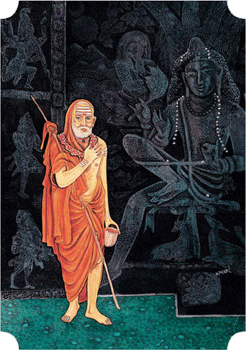 How Did the Sage of Kanchi Extol the Vedas?
How Did the Sage of Kanchi Extol the Vedas?
Sri Chandrashekharendra Saraswati wrote, “The Vedas are eternal and are the source of all creation. Their greatness is to be known in many ways. Their sound produces in our nadis (subtle nerve channels), as well as in the atmosphere, vibrations that are salutary not only to our own Self but to the entire world—to the good of mankind as well as of all other creatures.”§
Sri Chandrashekharendra Saraswati [1894–1994], 68th pontiff of Kanchi Kamakoti Pitham, depicted above, walked throughout India teaching of the Vedas. Here he is shown before an image of Siva as Dakshinamurti, the silent guru seated beneath a banyan tree. Above left, an earthen mandala on a wall of Muktinath Temple in Nepal.§
 HE CONCERN FOR ALL CREATION THAT FINDS expression in the Vedas is not shared by any other religion. Shanno astu dvipade shanchatushpade—this occurs in a mantra. The Vedas pray for the good of all creatures including bipeds, quadrupeds, etc. Even grass, shrubs, trees, mountains and the rivers are not excluded from their benign purview. The happy state of all these sentient creatures and inert objects is brought about through the special quality of the Vedas.§
HE CONCERN FOR ALL CREATION THAT FINDS expression in the Vedas is not shared by any other religion. Shanno astu dvipade shanchatushpade—this occurs in a mantra. The Vedas pray for the good of all creatures including bipeds, quadrupeds, etc. Even grass, shrubs, trees, mountains and the rivers are not excluded from their benign purview. The happy state of all these sentient creatures and inert objects is brought about through the special quality of the Vedas.§
“The Vedas are also notable for the lofty truths expressed in the mantras. The tenets of these scriptures have aroused the wonder of people of other lands, of other faiths. They are moved by the poetic beauty of the hymns, the subtle manner in which principles of social life are dealt with, the metaphysical truths embedded and expounded in them, and their moral instruction as well as scientific truths.§
“There are mantras that are specially valuable for their sound but are otherwise meaningless. Similarly, there are works pregnant with meaning but with no mantric power. The remarkable thing about the Vedas is that they are of immeasurable value as much for their sound as for their verbal content. While they have the mantric power to do immense good to each one of us and to the world, they also contain teachings embodying great metaphysical truths.§
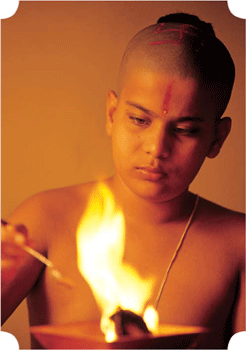 As when a fire is lit with damp fuel, different clouds of smoke come forth. In the same way from this great Being are breathed forth the Rig, Yajur, Sama and Atharva Vedas.§
As when a fire is lit with damp fuel, different clouds of smoke come forth. In the same way from this great Being are breathed forth the Rig, Yajur, Sama and Atharva Vedas.§
Shukla Yajur Veda, Brihadaranyaka Upanishad 2.4.10§
Above, an Indian boy piously pours ghee on the sacred fire, keeping the flame of devotion alive. At left, devotees worship the Sun in Bihar during Chhat festival, when, for one night and day, the people live on the banks of the river Ganga making offerings to Surya, the gracious Sun God, a primary Deity honored in the Vedas.§
“It must here be emphasized that on the doctrinal level the Vedas deal both with worldly life and the inner life of the Self. They teach how to conduct ourselves in such a manner as to create atmic well-being. And their concern is not with the liberation of the individual alone; they speak about the ideals of social life and about the duties of the public. How the brahmin ought to lead his life and how the king must rule his subjects and what ideals women are to follow: an answer to these—stated in the form of laws—is to be found in these scriptures.§
“My duty is to impress upon you that it is your responsibility to keep the Vedic tradition alive. If in India the Vedas retain their original vitality even today, it is because they are being continuously repeated by students and teachers of the Vedas, and the purity of the sounds and accents of the words are retained in that process. But it is only by practicing the Vedic injunctions that we can obtain the grace of God, both for our individual welfare and for the welfare of the whole world.”§

Life illumined with scriptural wisdom
 urudeva, Sivaya Subramuniyaswami, founder of HINDUISM TODAY, was once asked, “What can I say if a missionary comes to my door and asks, ‘Does Hinduism have a Bible?’ ” He answered, “You can say, ‘Yes, we have the Vedas and Agamas, plus a hundred other scriptures that serve us very well, thank you.’ ” Indeed, this diverse body of knowledge is unlike the one Holy Book of other world faiths. It is diverse, a bit neglected, some nearly lost, some actually lost, but all of it precious. Yet, it defines and colors Hindu life like the genetic code that makes a starfish a starfish. It is reflected in the beautiful Hindu style of music, art, drama, dance, work ethics, law, domestic values, spiritual striving, relationships, rites of passage, astrology, medicine, games, love and business, architecture and storytelling, government and diplomacy, and the working together of this physical world with the heavenly realms of existence. This grand legacy helps make Hindus the gracious people they are, with qualities of humility, appreciation, love of God, forbearance, joy and soulful depth of character.§
urudeva, Sivaya Subramuniyaswami, founder of HINDUISM TODAY, was once asked, “What can I say if a missionary comes to my door and asks, ‘Does Hinduism have a Bible?’ ” He answered, “You can say, ‘Yes, we have the Vedas and Agamas, plus a hundred other scriptures that serve us very well, thank you.’ ” Indeed, this diverse body of knowledge is unlike the one Holy Book of other world faiths. It is diverse, a bit neglected, some nearly lost, some actually lost, but all of it precious. Yet, it defines and colors Hindu life like the genetic code that makes a starfish a starfish. It is reflected in the beautiful Hindu style of music, art, drama, dance, work ethics, law, domestic values, spiritual striving, relationships, rites of passage, astrology, medicine, games, love and business, architecture and storytelling, government and diplomacy, and the working together of this physical world with the heavenly realms of existence. This grand legacy helps make Hindus the gracious people they are, with qualities of humility, appreciation, love of God, forbearance, joy and soulful depth of character.§
The soul is born and unfolds in a body, with dreams and desires and the food of life. And then it is reborn in new bodies in accordance with its former works. The quality of the soul determines its future body—earthly or airy, heavy or light.§
Shvetashvatara Upanishad, 5.11–12. The Upanishads, Mascsaro, p. 94§
With earnest effort hold the senses in check. Controlling the breath, regulate the vital activities. As a charioteer holds back his restive horses, so does a persevering aspirant restrain his mind.§
Shvetashvatara Upanishad, 2.9. The Upanishads, Prabhavananda & Manchester, p. 192§
The guru who has attained Self Realization can alone help the aspirant in acquiring it.§
Siva Sutras 2.6, Jaideva Singh, p. 102§
If daily to his home the friends who love him come, and coming, bring delight to eyes that kindle bright, a man has found the whole of life within his soul.§
Panchatantra, Ryder, p. 218§
In the beginning of worship, at the conclusion of the rite, in the offering of water, in the anointing of the image, in the bathing of the image, in the offering of light, in the sprinkling of the image with sandal, in the bathing of the image with consecrated liquids, in the offering of incense, in the act of worship, and in all other things to be done, the Sivacharya should strike the great bell.§
Karana Agama 190–191, Motivations of Temple Architecture in Saiva Siddhanta, p.160§
Mantra yields early success due to practice done in previous life. Self-fulfilling, too, is the mantra which is received according to the line of tradition, with due diksha, obtained in the right way. Innumerable are the mantras; they but distract the mind. Only that mantra which is received through the grace of the guru gives all fulfillment.§
Kularnava Tantra 11.3, Woodroff & Pandit, p. 112§
O thou who pervades all space, both now and hereafter, as the Soul of souls! The Vedas, Agamas, Puranas, Itihasas and all other sciences inculcate fully the tenet of nonduality. It is the inexplicable duality that leads to the knowledge of nonduality. This is consonant with reason, experience, tradition, and is admitted by the dualists and nondualists.§
Tayumanavar, 10.3, The Poems of Tayumanavar, Coomaraswamy, p. 44§
By overthrowing the aggregate of the six enemies [lust, anger, greed, vanity, haughtiness and overjoy], he shall restrain the organs of sense; acquire wisdom by keeping company with the aged; see through his spies; establish safety and security by being ever active; maintain his subjects in the observance of their respective duties by exercising authority; keep up his personal discipline by receiving lessons in the sciences; and endear himself to the people by bringing them in contact with wealth and doing good to them.§
Book I, Chapter 7, The Life of a Holy King, Kautilya’s Arthashastra, R. Shamasastry§
Once Rama asked Hanuman, “How do you look at Me?” And Hanuman replied: “O Rama, as long as I have the feeling of ‘I’, I see that Thou art the whole and I am a part; Thou art the Master and I am Thy servant. But when, O Rama, I have the knowledge of Truth, Then I realize that Thou art I, and I am Thou.”§
From the Ramayana, as quoted by Sri Ramakrishna Paramahamsa§
Let us have concord with our own people, and concord with people who are strangers to us. Aśvins, create between us and the strangers a unity of hearts.§
Atharva Veda Samhita, 7.52.1§
In him who is pure of mind, intellect and ego, the senses and their perceptions are pure, in fact, and he finds everything pure as well.§
Sarvajnanottara Agama, Atma Sakshatkara 62, Collected Works of Ramana Mararshi, p.110§
One who is established in the contemplation of nondual unity will abide in the Self of everyone and realize the immanent, all-pervading One. There is no doubt of this.§
Sarvajnanottara Agama, Atma Sakshatkara 14, Collected Works of Ramana Maharshi, p.107.§
The Self resides within the lotus of the heart. Knowing this, consecrated to the Self, the sage enters daily that holy sanctuary. Absorbed in the Self, the sage is freed from identity with the body and lives in blissful consciousness.§
Sama Veda, Chandogya Upanishad 8.3.3-4, The Upanishads, Prabhavananda & Manchester, p. 122
§
With the help of the gardeners called Mind and Love, plucking the flower called Steady Contemplation, offering the water of the flood of the Self’s own bliss, worship the Lord with the sacred formula of silence!§
Lalla, The Sources of Indian Tradition, p. 360§
The Lord of Appati is both inside and outside, form and no form. He is both the flood and the bank. He is the broad-rayed sun. Himself the highest mystery, He is in all hidden thoughts. He is thought and meaning, and embraces all who embrace Him.§
Tirumurai 4.48.7. Poems to Siva, The Hymns of the Tamil Saints, Peterson, p. 114§
At the time of the sacrifice, O Lord of the wood [Agni], the worshipers smear you with sacred oil. When you stand upright or when you repose on Earth’s bosom, you still will grant us good fortune. Set up to the East of the sacred fire, you accept our prayer, intense and unflagging. Hold yourself high to bring us prosperity. Drive far away dearth of inspiration. Lord of the wood, take now your stance on this, the loftiest spot of all Earth. Well-fixed and measured one, give to the worshiper, who brings a sacrifice, honor and glory.§
Rig Veda 3.8.1-3, The Vedic Experience, Pannikar, p. 373-374§
There is no difference between devotion and perfect knowledge. A person who is engrossed in devotion enjoys perpetual happiness. And perfect knowledge never descends in a vicious person averse to devotion.§
Siva Purana, Rudra Samhita. 23.16, Ancient Indian Tradition and Mythology, vol 1, p. 380§
As wide Earth, as fire and water, as sacrificer and wind that blows, as eternal moon and sun, as ether, as the eight-formed God, as cosmic good and evil, woman and man, all other forms and His own form, and all these as Himself, as yesterday and today and tomorrow, the God of the long, red hair stands, O Wonder!§
Tirumurai 6.308.1. Poems to Siva, The Hymns of the Tamil Saints, Peterson, p. 113§


